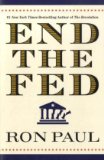END THE FED by Ron Paul, Grand Central Publishing 2009
Review by Alan F. Kay
Ron Paul, a darling of the Tea Party, is a medical doctor and the author of End the Fed, (Grand Central Publishing, 2009). He has served as a Republican Congressman (Texas) for 20 years, 1979-1985 and 1997-2011. As nominee of the Libertarian party, he ran for president in 1988. In 2008, he was a Republican presidential nominee, overtaken by the candidate Senator John McCain, who lost to President Obama. While Ron Paul was in the House in 2008, his son, Rand Paul, became a Republican Senator (Kentucky), creating a combination unique in the 200+ year period of Congress.
End the Fed summarizes why Ron Paul has been a scourge of the Federal Reserve System. The Fed has controlled monetary policy since 1913, in a bill signed and later regretted by President Woodrow Wilson. The Fed is a private system governed by its 12 regional member banks. The US President appoints the seven member Federal Reserve board, including its powerful chairman, with Senate confirmation. The US government plays a role but does not control the system. The Fed failed the country in the Great Depression (1930s) with its faulty policies.
In 2001-6, the Fed was not willing to curb the excesses of the mortgage industry which led to the housing bubble, even though they had the necessary authority. Neither did they warn of or avert disastrous behavior of the financial industry in the recent meltdown (2007 – 2008). Indeed, the Fed contributed to the financial crisis with low interest rates, keeping stock prices up on Wall Street after the dot-com bubble: known as “Greenspan’s Put.” The next bubble, in housing, is often called “Bernanke’s Put,” which continued after the $700 billion TARP in 2008. Wall Street mega-banks were then bailed out through the Fed’s discount window and later by Bernanke’s QE1 in 2010 and $600 billion QE2 in 2011.
Some big commercial banks believe that they “make markets” beyond their obligations to treat customers honestly, as Congressional hearings documented in 2010 (FCIC 2010 and Carl Levin, US Senate, 2011). Thus, these big banks accumulated trillions of dollars while the middle-class on Main Street were punished with low interest rates and the poor find it even harder to make ends meet. These “too-big-to-fail” banks took the Fed’s free money and speculated in derivatives, oil, food, and emerging markets in China, India, and Brazil.
Ron Paul painstakingly assembled a majority of votes in Congress to audit the Fed, joined by Freedom of Information lawsuits by Bloomberg and Fox News. Finally in 2011, the Fed was forced to open its books and divulge the names of all the big domestic and foreign banks which received US taxpayers funds. Fed Chairman Ben Bernanke, former Fed chairman Alan Greenspan and other officials, including former Treasury secretaries Larry Summers and Henry Paulson, as well as Tim Geithner, find themselves on the hot seat. Ron Paul and others knowledgeable about the Fed have asked many of the right questions. Their answers might begin to explain why the Fed has had such disasters and what reforms are needed in this new century.
End the Fed documents Paul’s tenacity over the years. Fed experts are polite but so far, even in the first-ever press conference, Ben Bernanke carefully and cautiously asserted that the Fed is helping or will help the economy improve in the short, medium, and long terms. The famous Fed obfuscations show that there are few if any clear agreements or understandings of what exactly is the definition of the “economy” or even how the US money-supply is created. Ron Paul has diagnosed many problems, but many of his prescriptions for the economy seem unrealistic – except his proposals to “end the US empire,” bring our troops home from Afghanistan and Iraq, and close many US bases from the Cold War!
Libertarians in general seek freedom from government interference in the “economy” while naively ignoring the power of corporations and special interests. Many of the Fed’s activities are being re-examined – particularly its power to create the nation’s money through the banking system rather than directly by government – as in the US Constitution. The banking system allows the financial industry too much power.
The Fed will not be easily replaced although influential groups of experts including the American Monetary Institute (AMI) have a sensible bill in Congress to return the money-creation power to the US Treasury rather than continuing to allow banks to create over 95% of the US money supply as bank loans, out of thin air. Another impressive approach is toward public banking systems, as described in www.publicbankinginstitute.org which has well explained that the State of North Dakota has been using successfully a public banking system for over 90 years. Recently, similar public systems are being considered by an increasing number of the US states, as are proposals by Lawrence Kotlikoff for “public utility banks” in Jimmy Stewart is Dead (2010).
End the Fed shows the many conflicts of interest in our financial system – also corroborated by the 2010 release of the Oscar-winning movie “Inside Job,” and as detailed at www.EthicalMarkets.com Reforming Global Finance and the Statement on Transforming Finance.
Alan F. Kay, Ph.D.
Author, Locating Consensus for Democracy and other books
Treasurer and Secretary, Ethical Markets Media (USA and Brazil)
10 Carrera Street, Saint Augustine, FL 32084
www.alanfkay.com and www.ethicalmarkets.com
i@alanfkay.com 904.826.0984

